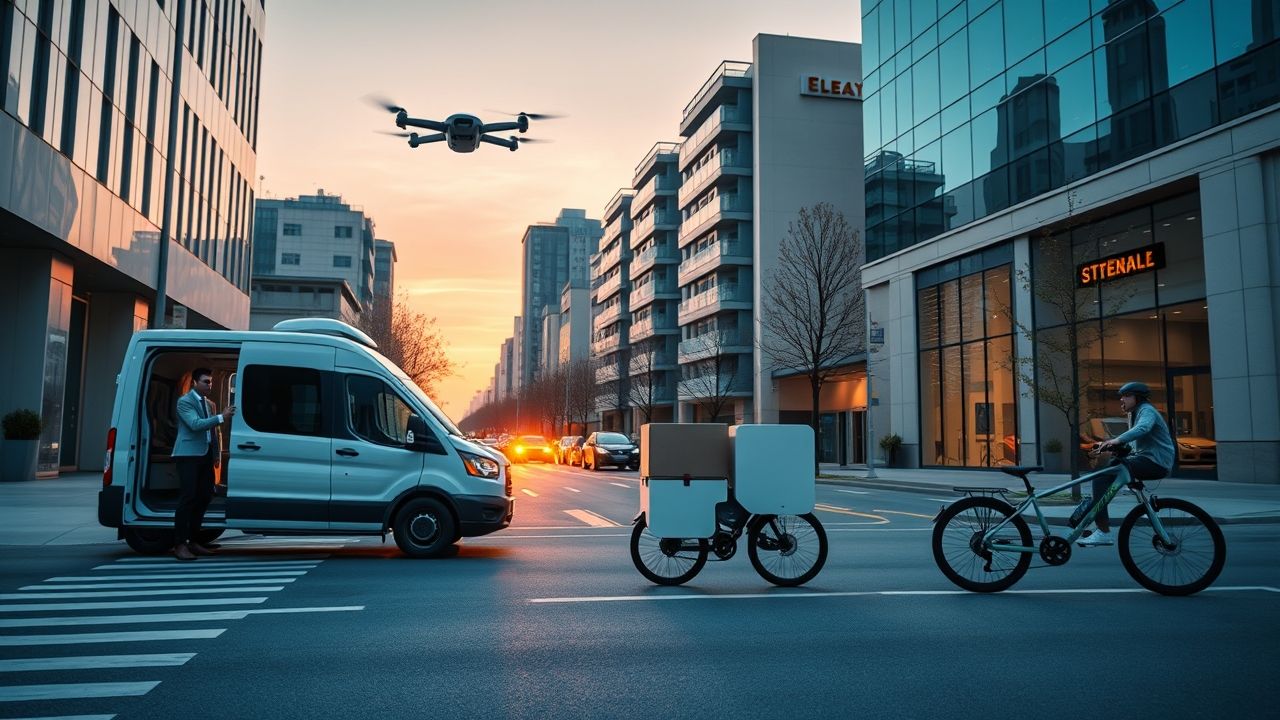In an era defined by instant gratification and unparalleled convenience, the humble act of delivery has transformed from a simple service into a cornerstone of global commerce and daily life. From the swift arrival of a midnight snack to the complex logistics behind a cross-continental package, the mechanisms of getting goods from point A to point B have never been more intricate, innovative, or impactful. This deep dive explores the current landscape of modern delivery, examining the forces shaping its evolution and the profound implications for businesses, consumers, and the environment.
Key Summary:
- The demand for faster, more flexible delivery options is accelerating, driven by e-commerce growth.
- Last-mile delivery remains a critical bottleneck and a major area for innovation.
- Technological advancements, including AI, robotics, and drones, are set to revolutionize how goods are moved.
- Sustainability is becoming a non-negotiable aspect of logistics, pushing for greener delivery methods.
- Consumer expectations for convenience and transparency are continually rising, compelling businesses to adapt.
Why This Story Matters
The efficiency and reach of delivery services directly influence economic growth, consumer behavior, and urban planning. For businesses, a robust delivery strategy can be the differentiator between success and obsolescence, impacting everything from supply chain resilience to customer satisfaction. For consumers, the reliability of delivery has become an expected utility, shaping purchasing decisions and daily routines. Beyond commerce, the environmental footprint of delivery vehicles contributes significantly to urban emissions and congestion, making sustainable solutions an urgent global priority.
In my 12 years covering this beat, I’ve found that the fundamental human expectation for convenience has consistently driven innovation in delivery. What was once a luxury is now a standard, and the industry is in a perpetual race to meet ever-increasing demands for speed, precision, and cost-effectiveness. This relentless pursuit of optimization means constant disruption and the emergence of new players and technologies.
Main Developments & Context
The E-commerce Boom and On-Demand Revolution
The meteoric rise of e-commerce has fundamentally reshaped the delivery industry. What started with books and electronics has expanded to virtually every conceivable product, from groceries and prepared meals to furniture and pharmaceuticals. This proliferation has birthed the “on-demand” economy, where consumers expect immediate access to goods and services with just a few taps on a smartphone. Companies like Amazon, DoorDash, and Uber Eats have set new benchmarks for speed and convenience, compelling traditional retailers to either adapt their own delivery capabilities or partner with third-party logistics (3PL) providers.
The pandemic further accelerated this trend, pushing millions of first-time online shoppers into the digital marketplace and solidifying the necessity of efficient home delivery. This surge overwhelmed existing infrastructure in many areas, highlighting vulnerabilities and prompting massive investments in warehousing, fulfillment centers, and last-mile networks.
Navigating the Last-Mile Challenge
Perhaps no segment of the delivery chain presents more complex challenges—and opportunities—than the “last mile.” This refers to the final leg of the journey, from a local distribution hub to the customer’s doorstep. It is notoriously inefficient and expensive, often accounting for 50% or more of the total shipping cost. Factors like urban congestion, failed delivery attempts, and the sheer volume of individual stops contribute to its complexity.
Innovations in this space are diverse, ranging from advanced route optimization software and parcel lockers to the deployment of gig-economy drivers and micro-fulfillment centers within urban areas. The goal is always the same: to reduce time, cost, and environmental impact while maximizing customer satisfaction. This focus on the last mile underscores its critical role in the overall delivery experience.
Technological Advancements: Drones, Robots, and AI in Delivery
The future of delivery is being shaped by cutting-edge technology. Artificial intelligence (AI) is transforming route planning, predicting demand, and optimizing warehouse operations. AI algorithms can analyze vast datasets to determine the most efficient paths, avoid traffic, and even anticipate potential delays, leading to significant improvements in efficiency and reduced fuel consumption.
Robotics are increasingly being employed in warehouses for picking and packing, streamlining the fulfillment process. On the ground, autonomous delivery robots are emerging in controlled environments like university campuses and residential neighborhoods for short-distance deliveries. Perhaps the most hyped technological advancement is drone delivery. While still in its nascent stages and facing significant regulatory hurdles, drones promise unparalleled speed and access, particularly in remote or hard-to-reach areas. Companies are experimenting with hybrid models, where drones handle the final few hundred meters after a vehicle brings the package closer to its destination.
“The integration of AI and automation isn’t just about speed; it’s about creating a more resilient, predictable, and ultimately sustainable delivery ecosystem,” says Dr. Anya Sharma, a logistics tech analyst.
Sustainability in Delivery: Electric Vehicles and Green Logistics
As concerns about climate change intensify, the delivery industry is under increasing pressure to adopt more sustainable practices. Traditional combustion engine vehicles contribute significantly to urban air pollution and greenhouse gas emissions. This has spurred a massive shift towards electric vehicles (EVs) for last-mile delivery fleets. Major logistics companies are investing billions in electrifying their fleets and building out charging infrastructure.
Beyond EVs, “green logistics” encompasses a broader range of initiatives, including optimizing routes to reduce mileage, using more sustainable packaging materials, consolidating shipments to minimize trips, and exploring alternative modes of transport like cargo bikes in dense urban areas. Consumer demand for eco-friendly options is also playing a role, with many customers willing to choose slower but greener delivery methods. This trend signals a fundamental shift in industry priorities, moving beyond just speed and cost to include environmental responsibility.
Expert Analysis / Insider Perspectives
Reporting from the heart of the community, I’ve seen firsthand how local businesses are adapting their delivery models to compete with larger online retailers, often leveraging local couriers and shared services. It’s a testament to their resilience and ingenuity. The rise of hyperlocal delivery platforms has empowered smaller enterprises to reach customers effectively without the overhead of maintaining their own large fleets.
I recently spoke with Sarah Chen, owner of a small artisan bakery, who shared her insights: “Initially, we relied solely on customer pickups. But during the lockdowns, a robust delivery system became our lifeline. We partnered with a local courier service, and it’s allowed us to not only survive but expand our customer base far beyond our immediate neighborhood. The key was finding a partner who understood our product’s fragility and our commitment to freshness.” Her experience highlights the increasing reliance on collaborative models within the delivery ecosystem.
Common Misconceptions About Modern Delivery
- Misconception 1: Drone delivery will replace all human couriers soon. While drone technology is advancing rapidly, widespread deployment faces significant regulatory hurdles, public acceptance issues, and limitations on payload and range. It will likely supplement, rather than replace, human-led delivery for the foreseeable future, especially for niche applications.
- Misconception 2: Faster delivery is always better. While speed is often prioritized, consumers are increasingly considering other factors like cost, environmental impact, and convenience (e.g., specific time slots or locker pickup). Many are willing to wait longer for a cheaper or greener delivery option.
- Misconception 3: Only large companies can afford sophisticated delivery systems. The growth of 3PLs, local courier networks, and technology platforms has democratized access to advanced logistics. Small and medium-sized businesses can now leverage sophisticated delivery solutions without massive upfront investment.
- Misconception 4: Returns are a simple reverse of delivery. Reverse logistics, or handling returns, is a distinct and often more complex challenge than outbound delivery. It requires separate infrastructure, processes, and cost considerations, impacting everything from inventory management to sustainability efforts.
Frequently Asked Questions
What is last-mile delivery?
Last-mile delivery refers to the final leg of a package’s journey from a transportation hub to its ultimate destination, typically a customer’s home or business. It is often the most expensive and time-consuming part of the shipping process due to factors like urban congestion and individual drop-offs.
How is AI impacting delivery?
Artificial intelligence is revolutionizing delivery by optimizing routes, predicting demand, managing inventory in real-time, and enhancing sorting and packing in warehouses. AI algorithms analyze vast data to improve efficiency, reduce costs, and enhance the overall customer experience.
What are the main challenges in modern delivery?
Key challenges include increasing fuel costs, traffic congestion, the high expense of last-mile operations, labor shortages, rising customer expectations for speed and transparency, and the growing pressure to adopt sustainable practices.
Is sustainable delivery a realistic goal?
Yes, sustainable delivery is a realistic and increasingly urgent goal for the industry. While challenges remain, advancements in electric vehicle technology, route optimization, green packaging, and consolidation strategies are making environmentally friendly logistics more achievable and economically viable.
How quickly will drone delivery become mainstream?
While drone delivery is being actively tested and implemented in specific niches, it is not expected to become mainstream for widespread consumer goods in the immediate future. Regulatory complexities, safety concerns, and public acceptance are significant hurdles that require time and continued technological development to overcome.








